Business Administration Project Report: Cost-Benefit Analysis & Risk
VerifiedAdded on 2020/12/09
|12
|3973
|421
Report
AI Summary
This report provides a comprehensive analysis of a business administration project, using Marks and Spencer (M&S) as a case study. It delves into various aspects of project management, including cost-benefit analysis, risk analysis techniques, and the application of project planning and management tools. The report examines the impact of changes to project scope, schedule, finance, risk, quality, and resources, along with the requirements of project governance arrangements. It also explores how a project fits within an organization's vision and objectives, including the development of project plans with key performance indicators (KPIs) and risk management strategies. The report discusses resource allocation, project team roles, and communication strategies, as well as the application of project life cycle approaches. It highlights the importance of project governance and the effective capture and management of project-related knowledge. The report includes an introduction, tasks analysis, conclusion, and references.
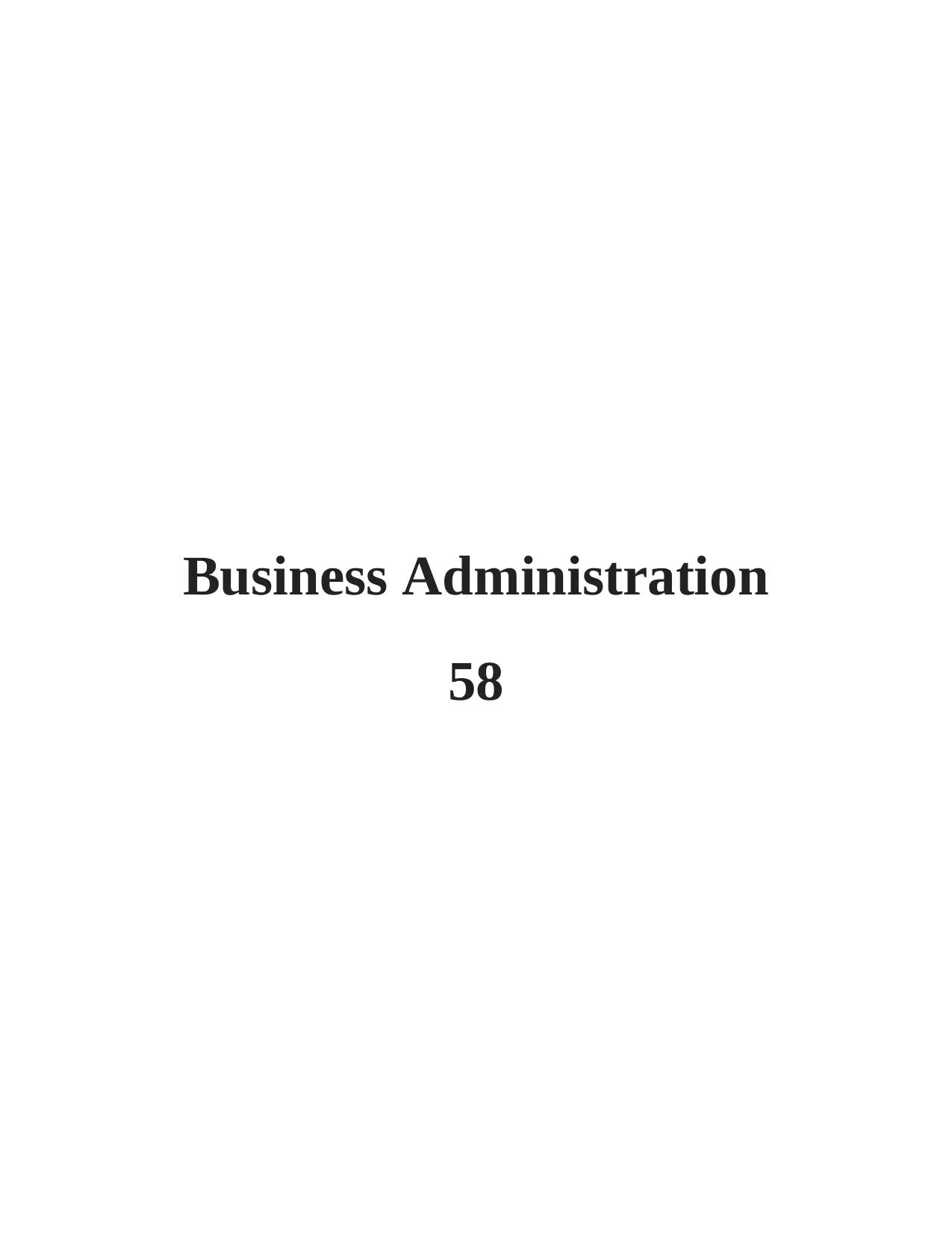
Business Administration
58
58
Paraphrase This Document
Need a fresh take? Get an instant paraphrase of this document with our AI Paraphraser
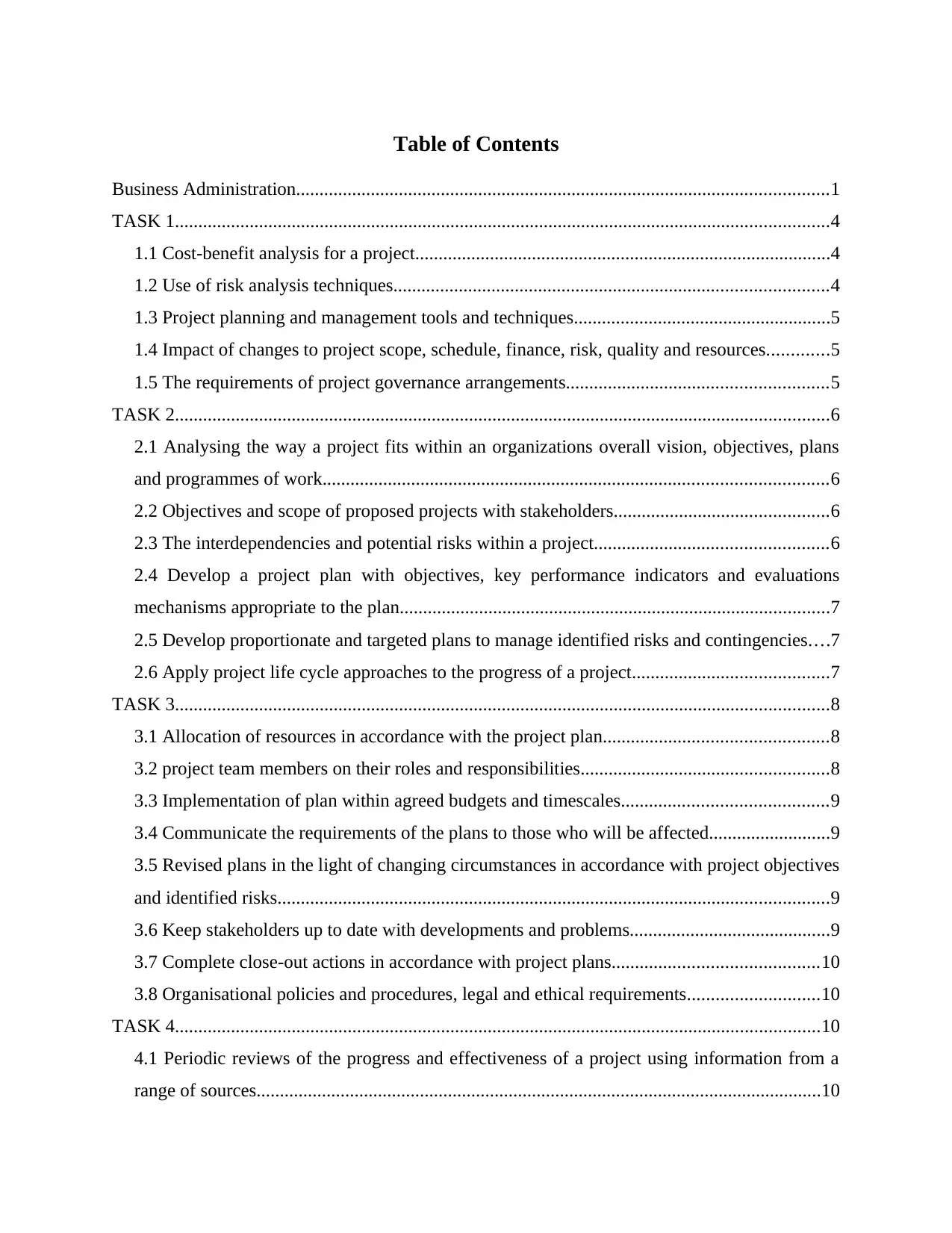
Table of Contents
Business Administration..................................................................................................................1
TASK 1............................................................................................................................................4
1.1 Cost-benefit analysis for a project.........................................................................................4
1.2 Use of risk analysis techniques.............................................................................................4
1.3 Project planning and management tools and techniques.......................................................5
1.4 Impact of changes to project scope, schedule, finance, risk, quality and resources.............5
1.5 The requirements of project governance arrangements........................................................5
TASK 2............................................................................................................................................6
2.1 Analysing the way a project fits within an organizations overall vision, objectives, plans
and programmes of work............................................................................................................6
2.2 Objectives and scope of proposed projects with stakeholders..............................................6
2.3 The interdependencies and potential risks within a project..................................................6
2.4 Develop a project plan with objectives, key performance indicators and evaluations
mechanisms appropriate to the plan............................................................................................7
2.5 Develop proportionate and targeted plans to manage identified risks and contingencies....7
2.6 Apply project life cycle approaches to the progress of a project..........................................7
TASK 3............................................................................................................................................8
3.1 Allocation of resources in accordance with the project plan................................................8
3.2 project team members on their roles and responsibilities.....................................................8
3.3 Implementation of plan within agreed budgets and timescales............................................9
3.4 Communicate the requirements of the plans to those who will be affected..........................9
3.5 Revised plans in the light of changing circumstances in accordance with project objectives
and identified risks......................................................................................................................9
3.6 Keep stakeholders up to date with developments and problems...........................................9
3.7 Complete close-out actions in accordance with project plans............................................10
3.8 Organisational policies and procedures, legal and ethical requirements............................10
TASK 4..........................................................................................................................................10
4.1 Periodic reviews of the progress and effectiveness of a project using information from a
range of sources.........................................................................................................................10
Business Administration..................................................................................................................1
TASK 1............................................................................................................................................4
1.1 Cost-benefit analysis for a project.........................................................................................4
1.2 Use of risk analysis techniques.............................................................................................4
1.3 Project planning and management tools and techniques.......................................................5
1.4 Impact of changes to project scope, schedule, finance, risk, quality and resources.............5
1.5 The requirements of project governance arrangements........................................................5
TASK 2............................................................................................................................................6
2.1 Analysing the way a project fits within an organizations overall vision, objectives, plans
and programmes of work............................................................................................................6
2.2 Objectives and scope of proposed projects with stakeholders..............................................6
2.3 The interdependencies and potential risks within a project..................................................6
2.4 Develop a project plan with objectives, key performance indicators and evaluations
mechanisms appropriate to the plan............................................................................................7
2.5 Develop proportionate and targeted plans to manage identified risks and contingencies....7
2.6 Apply project life cycle approaches to the progress of a project..........................................7
TASK 3............................................................................................................................................8
3.1 Allocation of resources in accordance with the project plan................................................8
3.2 project team members on their roles and responsibilities.....................................................8
3.3 Implementation of plan within agreed budgets and timescales............................................9
3.4 Communicate the requirements of the plans to those who will be affected..........................9
3.5 Revised plans in the light of changing circumstances in accordance with project objectives
and identified risks......................................................................................................................9
3.6 Keep stakeholders up to date with developments and problems...........................................9
3.7 Complete close-out actions in accordance with project plans............................................10
3.8 Organisational policies and procedures, legal and ethical requirements............................10
TASK 4..........................................................................................................................................10
4.1 Periodic reviews of the progress and effectiveness of a project using information from a
range of sources.........................................................................................................................10
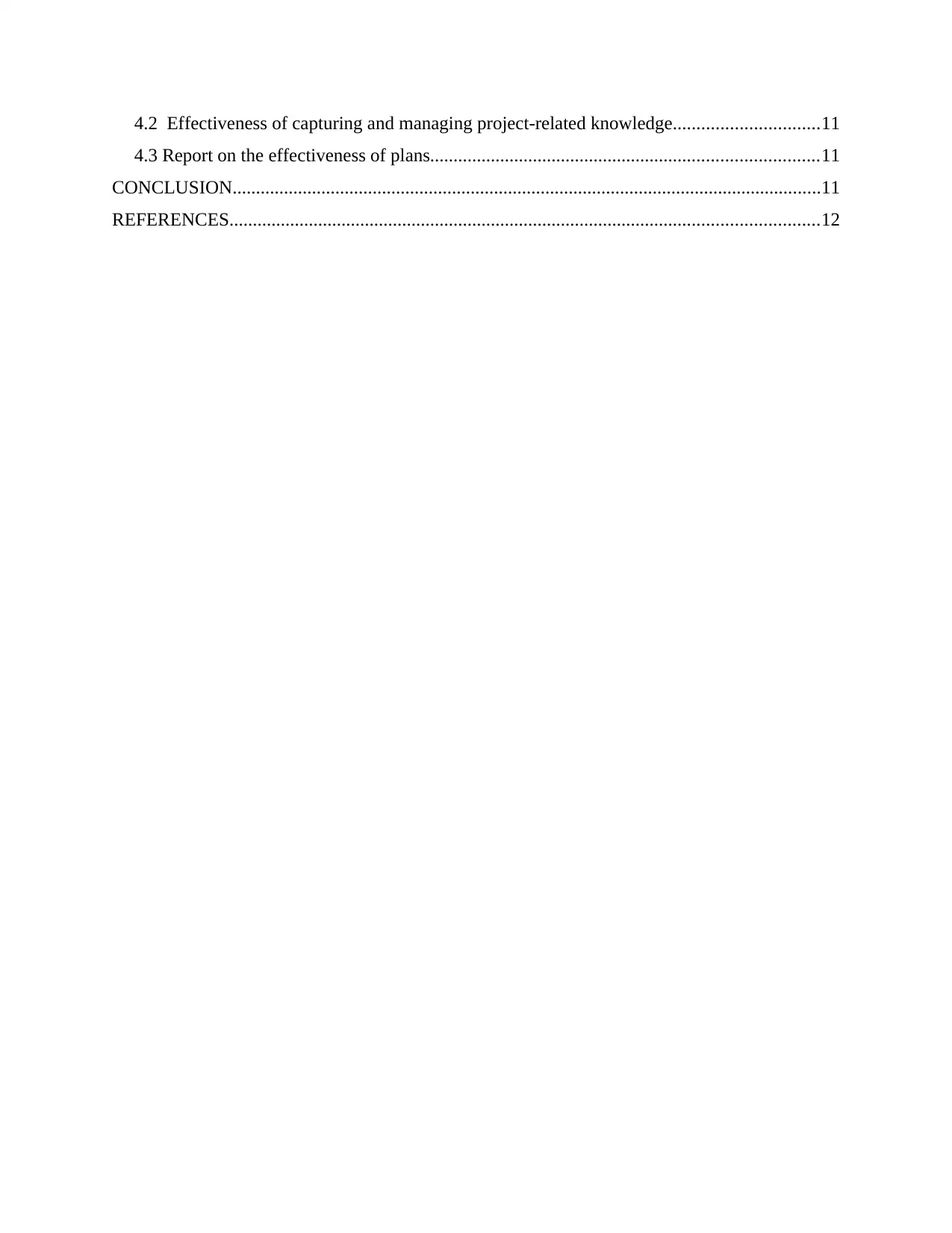
4.2 Effectiveness of capturing and managing project-related knowledge...............................11
4.3 Report on the effectiveness of plans...................................................................................11
CONCLUSION..............................................................................................................................11
REFERENCES..............................................................................................................................12
4.3 Report on the effectiveness of plans...................................................................................11
CONCLUSION..............................................................................................................................11
REFERENCES..............................................................................................................................12
⊘ This is a preview!⊘
Do you want full access?
Subscribe today to unlock all pages.

Trusted by 1+ million students worldwide
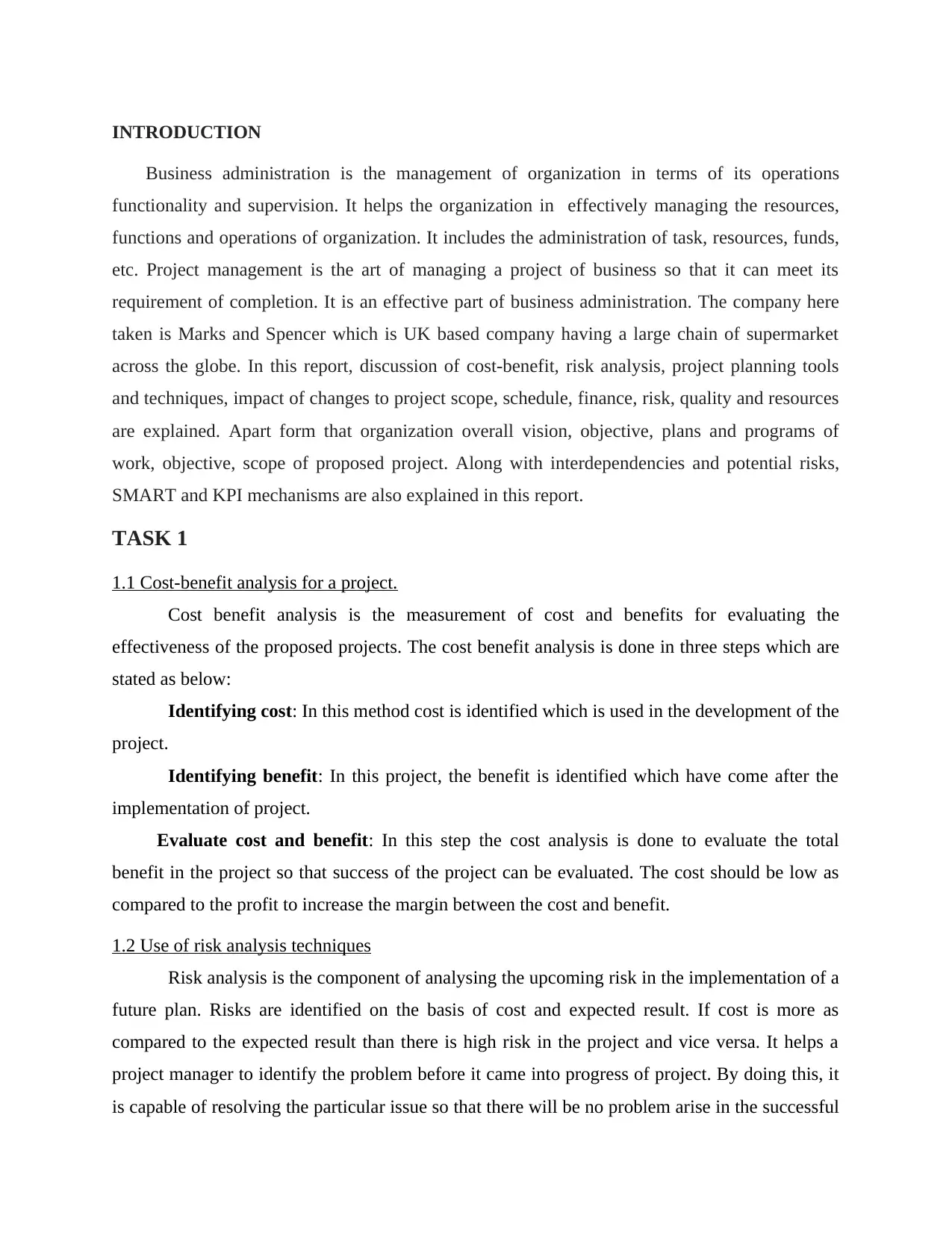
INTRODUCTION
Business administration is the management of organization in terms of its operations
functionality and supervision. It helps the organization in effectively managing the resources,
functions and operations of organization. It includes the administration of task, resources, funds,
etc. Project management is the art of managing a project of business so that it can meet its
requirement of completion. It is an effective part of business administration. The company here
taken is Marks and Spencer which is UK based company having a large chain of supermarket
across the globe. In this report, discussion of cost-benefit, risk analysis, project planning tools
and techniques, impact of changes to project scope, schedule, finance, risk, quality and resources
are explained. Apart form that organization overall vision, objective, plans and programs of
work, objective, scope of proposed project. Along with interdependencies and potential risks,
SMART and KPI mechanisms are also explained in this report.
TASK 1
1.1 Cost-benefit analysis for a project.
Cost benefit analysis is the measurement of cost and benefits for evaluating the
effectiveness of the proposed projects. The cost benefit analysis is done in three steps which are
stated as below:
Identifying cost: In this method cost is identified which is used in the development of the
project.
Identifying benefit: In this project, the benefit is identified which have come after the
implementation of project.
Evaluate cost and benefit: In this step the cost analysis is done to evaluate the total
benefit in the project so that success of the project can be evaluated. The cost should be low as
compared to the profit to increase the margin between the cost and benefit.
1.2 Use of risk analysis techniques
Risk analysis is the component of analysing the upcoming risk in the implementation of a
future plan. Risks are identified on the basis of cost and expected result. If cost is more as
compared to the expected result than there is high risk in the project and vice versa. It helps a
project manager to identify the problem before it came into progress of project. By doing this, it
is capable of resolving the particular issue so that there will be no problem arise in the successful
Business administration is the management of organization in terms of its operations
functionality and supervision. It helps the organization in effectively managing the resources,
functions and operations of organization. It includes the administration of task, resources, funds,
etc. Project management is the art of managing a project of business so that it can meet its
requirement of completion. It is an effective part of business administration. The company here
taken is Marks and Spencer which is UK based company having a large chain of supermarket
across the globe. In this report, discussion of cost-benefit, risk analysis, project planning tools
and techniques, impact of changes to project scope, schedule, finance, risk, quality and resources
are explained. Apart form that organization overall vision, objective, plans and programs of
work, objective, scope of proposed project. Along with interdependencies and potential risks,
SMART and KPI mechanisms are also explained in this report.
TASK 1
1.1 Cost-benefit analysis for a project.
Cost benefit analysis is the measurement of cost and benefits for evaluating the
effectiveness of the proposed projects. The cost benefit analysis is done in three steps which are
stated as below:
Identifying cost: In this method cost is identified which is used in the development of the
project.
Identifying benefit: In this project, the benefit is identified which have come after the
implementation of project.
Evaluate cost and benefit: In this step the cost analysis is done to evaluate the total
benefit in the project so that success of the project can be evaluated. The cost should be low as
compared to the profit to increase the margin between the cost and benefit.
1.2 Use of risk analysis techniques
Risk analysis is the component of analysing the upcoming risk in the implementation of a
future plan. Risks are identified on the basis of cost and expected result. If cost is more as
compared to the expected result than there is high risk in the project and vice versa. It helps a
project manager to identify the problem before it came into progress of project. By doing this, it
is capable of resolving the particular issue so that there will be no problem arise in the successful
Paraphrase This Document
Need a fresh take? Get an instant paraphrase of this document with our AI Paraphraser
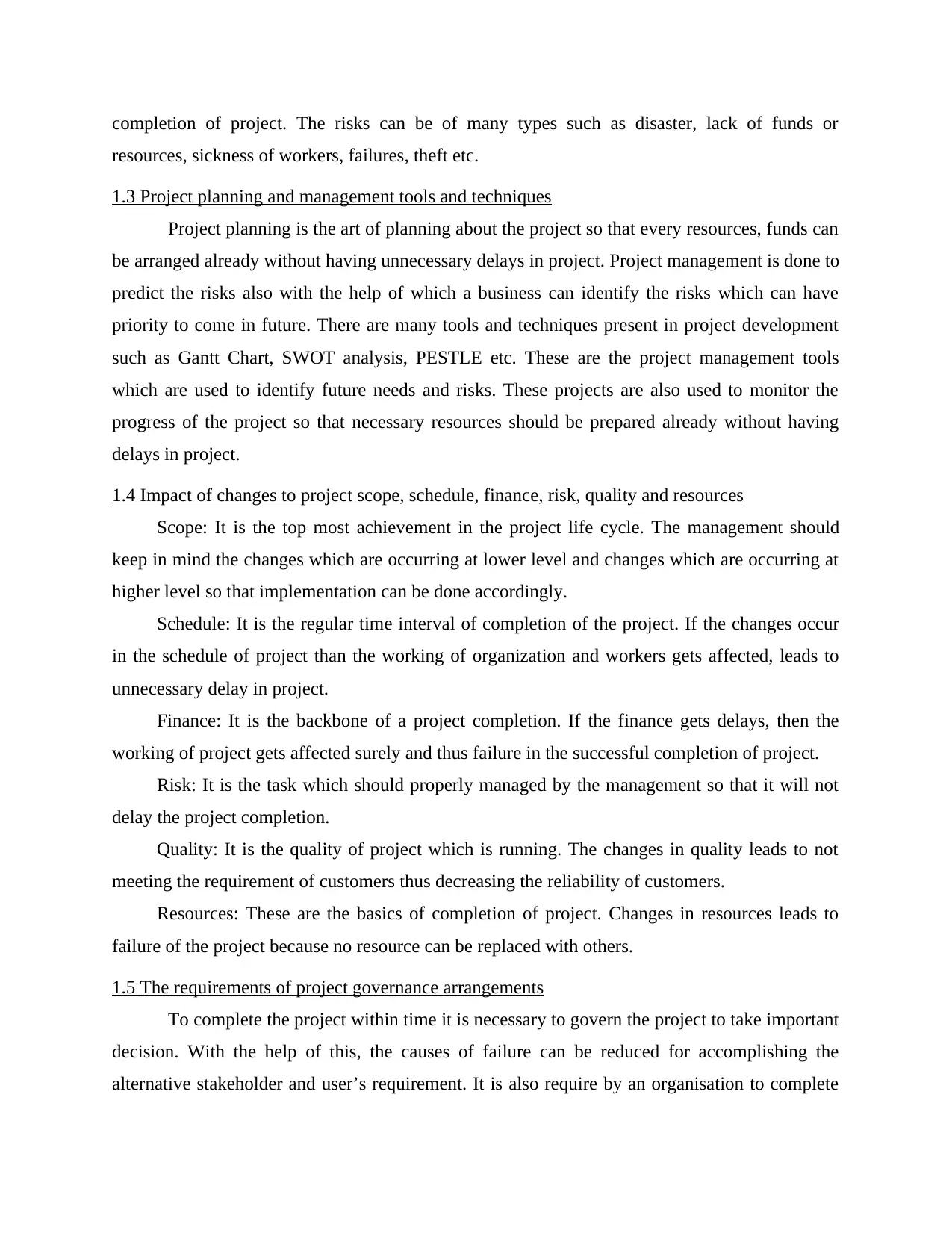
completion of project. The risks can be of many types such as disaster, lack of funds or
resources, sickness of workers, failures, theft etc.
1.3 Project planning and management tools and techniques
Project planning is the art of planning about the project so that every resources, funds can
be arranged already without having unnecessary delays in project. Project management is done to
predict the risks also with the help of which a business can identify the risks which can have
priority to come in future. There are many tools and techniques present in project development
such as Gantt Chart, SWOT analysis, PESTLE etc. These are the project management tools
which are used to identify future needs and risks. These projects are also used to monitor the
progress of the project so that necessary resources should be prepared already without having
delays in project.
1.4 Impact of changes to project scope, schedule, finance, risk, quality and resources
Scope: It is the top most achievement in the project life cycle. The management should
keep in mind the changes which are occurring at lower level and changes which are occurring at
higher level so that implementation can be done accordingly.
Schedule: It is the regular time interval of completion of the project. If the changes occur
in the schedule of project than the working of organization and workers gets affected, leads to
unnecessary delay in project.
Finance: It is the backbone of a project completion. If the finance gets delays, then the
working of project gets affected surely and thus failure in the successful completion of project.
Risk: It is the task which should properly managed by the management so that it will not
delay the project completion.
Quality: It is the quality of project which is running. The changes in quality leads to not
meeting the requirement of customers thus decreasing the reliability of customers.
Resources: These are the basics of completion of project. Changes in resources leads to
failure of the project because no resource can be replaced with others.
1.5 The requirements of project governance arrangements
To complete the project within time it is necessary to govern the project to take important
decision. With the help of this, the causes of failure can be reduced for accomplishing the
alternative stakeholder and user’s requirement. It is also require by an organisation to complete
resources, sickness of workers, failures, theft etc.
1.3 Project planning and management tools and techniques
Project planning is the art of planning about the project so that every resources, funds can
be arranged already without having unnecessary delays in project. Project management is done to
predict the risks also with the help of which a business can identify the risks which can have
priority to come in future. There are many tools and techniques present in project development
such as Gantt Chart, SWOT analysis, PESTLE etc. These are the project management tools
which are used to identify future needs and risks. These projects are also used to monitor the
progress of the project so that necessary resources should be prepared already without having
delays in project.
1.4 Impact of changes to project scope, schedule, finance, risk, quality and resources
Scope: It is the top most achievement in the project life cycle. The management should
keep in mind the changes which are occurring at lower level and changes which are occurring at
higher level so that implementation can be done accordingly.
Schedule: It is the regular time interval of completion of the project. If the changes occur
in the schedule of project than the working of organization and workers gets affected, leads to
unnecessary delay in project.
Finance: It is the backbone of a project completion. If the finance gets delays, then the
working of project gets affected surely and thus failure in the successful completion of project.
Risk: It is the task which should properly managed by the management so that it will not
delay the project completion.
Quality: It is the quality of project which is running. The changes in quality leads to not
meeting the requirement of customers thus decreasing the reliability of customers.
Resources: These are the basics of completion of project. Changes in resources leads to
failure of the project because no resource can be replaced with others.
1.5 The requirements of project governance arrangements
To complete the project within time it is necessary to govern the project to take important
decision. With the help of this, the causes of failure can be reduced for accomplishing the
alternative stakeholder and user’s requirement. It is also require by an organisation to complete
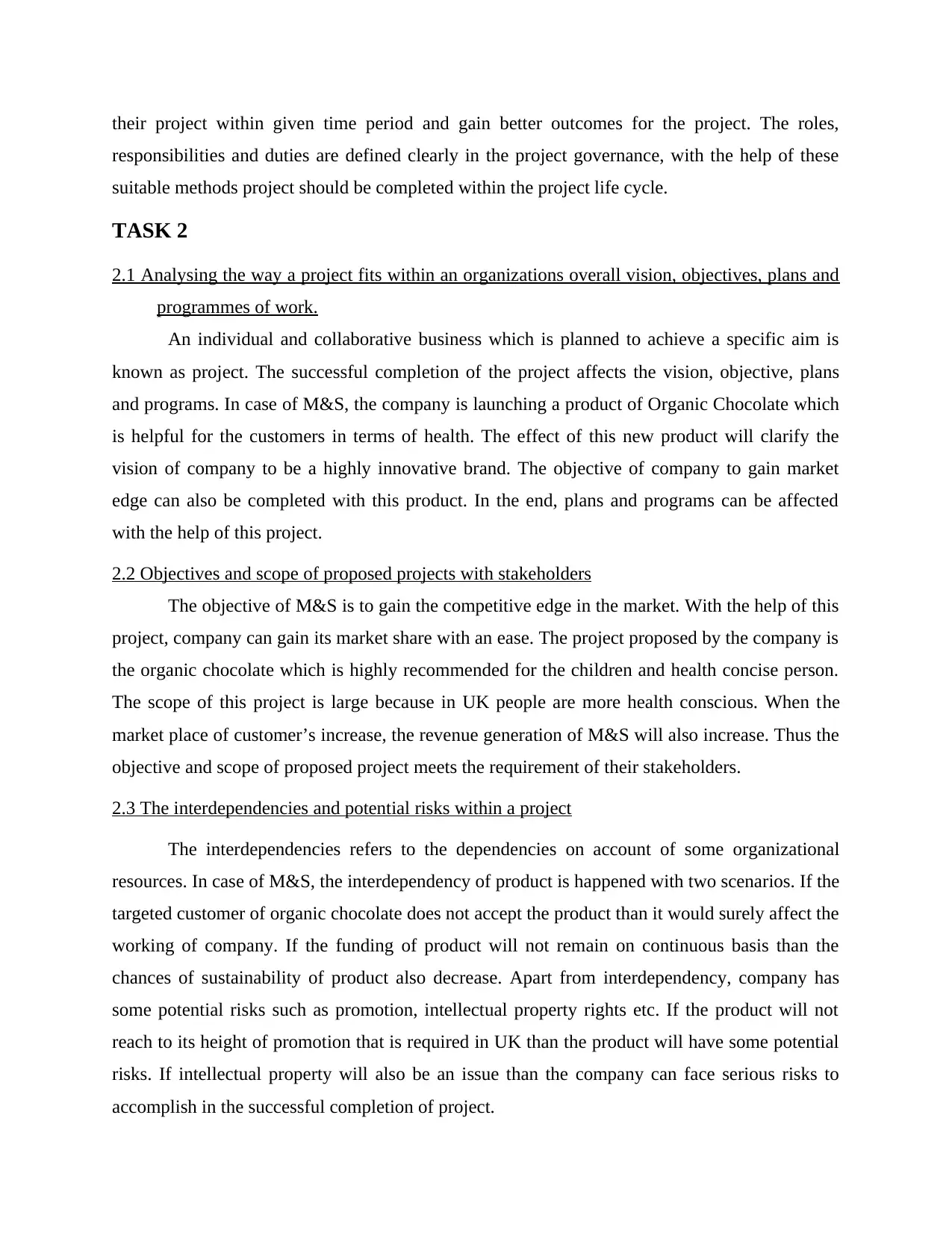
their project within given time period and gain better outcomes for the project. The roles,
responsibilities and duties are defined clearly in the project governance, with the help of these
suitable methods project should be completed within the project life cycle.
TASK 2
2.1 Analysing the way a project fits within an organizations overall vision, objectives, plans and
programmes of work.
An individual and collaborative business which is planned to achieve a specific aim is
known as project. The successful completion of the project affects the vision, objective, plans
and programs. In case of M&S, the company is launching a product of Organic Chocolate which
is helpful for the customers in terms of health. The effect of this new product will clarify the
vision of company to be a highly innovative brand. The objective of company to gain market
edge can also be completed with this product. In the end, plans and programs can be affected
with the help of this project.
2.2 Objectives and scope of proposed projects with stakeholders
The objective of M&S is to gain the competitive edge in the market. With the help of this
project, company can gain its market share with an ease. The project proposed by the company is
the organic chocolate which is highly recommended for the children and health concise person.
The scope of this project is large because in UK people are more health conscious. When the
market place of customer’s increase, the revenue generation of M&S will also increase. Thus the
objective and scope of proposed project meets the requirement of their stakeholders.
2.3 The interdependencies and potential risks within a project
The interdependencies refers to the dependencies on account of some organizational
resources. In case of M&S, the interdependency of product is happened with two scenarios. If the
targeted customer of organic chocolate does not accept the product than it would surely affect the
working of company. If the funding of product will not remain on continuous basis than the
chances of sustainability of product also decrease. Apart from interdependency, company has
some potential risks such as promotion, intellectual property rights etc. If the product will not
reach to its height of promotion that is required in UK than the product will have some potential
risks. If intellectual property will also be an issue than the company can face serious risks to
accomplish in the successful completion of project.
responsibilities and duties are defined clearly in the project governance, with the help of these
suitable methods project should be completed within the project life cycle.
TASK 2
2.1 Analysing the way a project fits within an organizations overall vision, objectives, plans and
programmes of work.
An individual and collaborative business which is planned to achieve a specific aim is
known as project. The successful completion of the project affects the vision, objective, plans
and programs. In case of M&S, the company is launching a product of Organic Chocolate which
is helpful for the customers in terms of health. The effect of this new product will clarify the
vision of company to be a highly innovative brand. The objective of company to gain market
edge can also be completed with this product. In the end, plans and programs can be affected
with the help of this project.
2.2 Objectives and scope of proposed projects with stakeholders
The objective of M&S is to gain the competitive edge in the market. With the help of this
project, company can gain its market share with an ease. The project proposed by the company is
the organic chocolate which is highly recommended for the children and health concise person.
The scope of this project is large because in UK people are more health conscious. When the
market place of customer’s increase, the revenue generation of M&S will also increase. Thus the
objective and scope of proposed project meets the requirement of their stakeholders.
2.3 The interdependencies and potential risks within a project
The interdependencies refers to the dependencies on account of some organizational
resources. In case of M&S, the interdependency of product is happened with two scenarios. If the
targeted customer of organic chocolate does not accept the product than it would surely affect the
working of company. If the funding of product will not remain on continuous basis than the
chances of sustainability of product also decrease. Apart from interdependency, company has
some potential risks such as promotion, intellectual property rights etc. If the product will not
reach to its height of promotion that is required in UK than the product will have some potential
risks. If intellectual property will also be an issue than the company can face serious risks to
accomplish in the successful completion of project.
⊘ This is a preview!⊘
Do you want full access?
Subscribe today to unlock all pages.

Trusted by 1+ million students worldwide
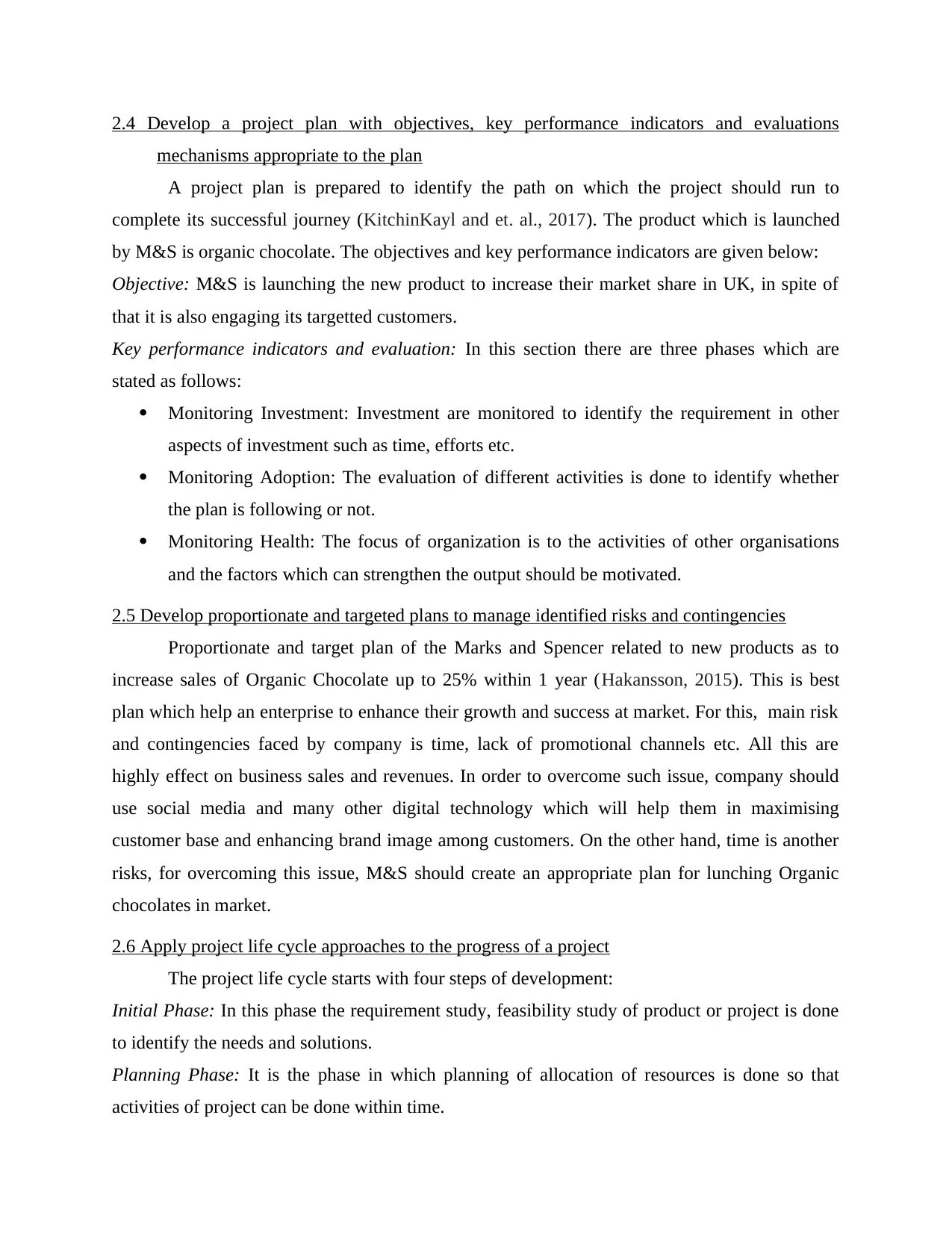
2.4 Develop a project plan with objectives, key performance indicators and evaluations
mechanisms appropriate to the plan
A project plan is prepared to identify the path on which the project should run to
complete its successful journey (KitchinKayl and et. al., 2017). The product which is launched
by M&S is organic chocolate. The objectives and key performance indicators are given below:
Objective: M&S is launching the new product to increase their market share in UK, in spite of
that it is also engaging its targetted customers.
Key performance indicators and evaluation: In this section there are three phases which are
stated as follows:
Monitoring Investment: Investment are monitored to identify the requirement in other
aspects of investment such as time, efforts etc.
Monitoring Adoption: The evaluation of different activities is done to identify whether
the plan is following or not.
Monitoring Health: The focus of organization is to the activities of other organisations
and the factors which can strengthen the output should be motivated.
2.5 Develop proportionate and targeted plans to manage identified risks and contingencies
Proportionate and target plan of the Marks and Spencer related to new products as to
increase sales of Organic Chocolate up to 25% within 1 year (Hakansson, 2015). This is best
plan which help an enterprise to enhance their growth and success at market. For this, main risk
and contingencies faced by company is time, lack of promotional channels etc. All this are
highly effect on business sales and revenues. In order to overcome such issue, company should
use social media and many other digital technology which will help them in maximising
customer base and enhancing brand image among customers. On the other hand, time is another
risks, for overcoming this issue, M&S should create an appropriate plan for lunching Organic
chocolates in market.
2.6 Apply project life cycle approaches to the progress of a project
The project life cycle starts with four steps of development:
Initial Phase: In this phase the requirement study, feasibility study of product or project is done
to identify the needs and solutions.
Planning Phase: It is the phase in which planning of allocation of resources is done so that
activities of project can be done within time.
mechanisms appropriate to the plan
A project plan is prepared to identify the path on which the project should run to
complete its successful journey (KitchinKayl and et. al., 2017). The product which is launched
by M&S is organic chocolate. The objectives and key performance indicators are given below:
Objective: M&S is launching the new product to increase their market share in UK, in spite of
that it is also engaging its targetted customers.
Key performance indicators and evaluation: In this section there are three phases which are
stated as follows:
Monitoring Investment: Investment are monitored to identify the requirement in other
aspects of investment such as time, efforts etc.
Monitoring Adoption: The evaluation of different activities is done to identify whether
the plan is following or not.
Monitoring Health: The focus of organization is to the activities of other organisations
and the factors which can strengthen the output should be motivated.
2.5 Develop proportionate and targeted plans to manage identified risks and contingencies
Proportionate and target plan of the Marks and Spencer related to new products as to
increase sales of Organic Chocolate up to 25% within 1 year (Hakansson, 2015). This is best
plan which help an enterprise to enhance their growth and success at market. For this, main risk
and contingencies faced by company is time, lack of promotional channels etc. All this are
highly effect on business sales and revenues. In order to overcome such issue, company should
use social media and many other digital technology which will help them in maximising
customer base and enhancing brand image among customers. On the other hand, time is another
risks, for overcoming this issue, M&S should create an appropriate plan for lunching Organic
chocolates in market.
2.6 Apply project life cycle approaches to the progress of a project
The project life cycle starts with four steps of development:
Initial Phase: In this phase the requirement study, feasibility study of product or project is done
to identify the needs and solutions.
Planning Phase: It is the phase in which planning of allocation of resources is done so that
activities of project can be done within time.
Paraphrase This Document
Need a fresh take? Get an instant paraphrase of this document with our AI Paraphraser
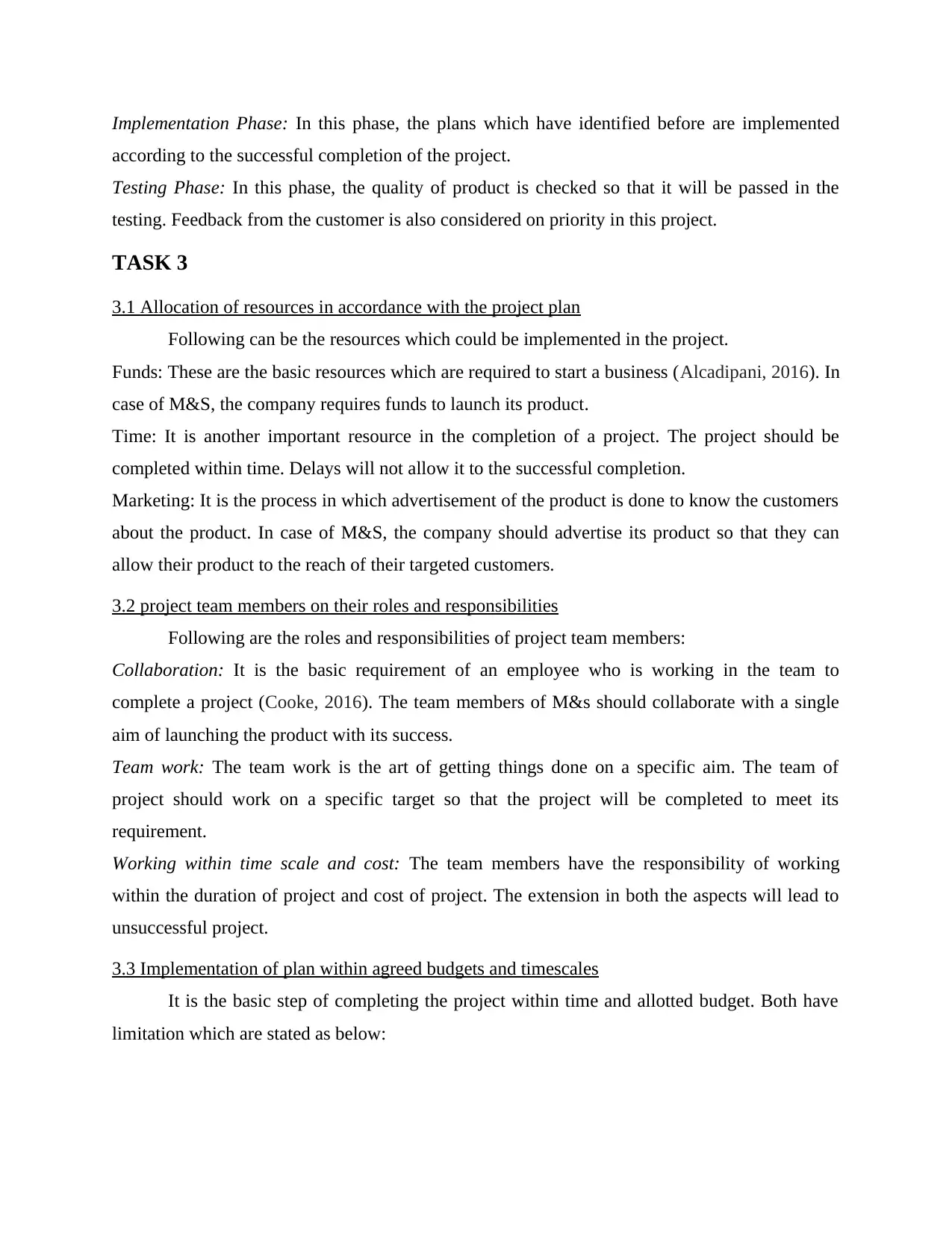
Implementation Phase: In this phase, the plans which have identified before are implemented
according to the successful completion of the project.
Testing Phase: In this phase, the quality of product is checked so that it will be passed in the
testing. Feedback from the customer is also considered on priority in this project.
TASK 3
3.1 Allocation of resources in accordance with the project plan
Following can be the resources which could be implemented in the project.
Funds: These are the basic resources which are required to start a business (Alcadipani, 2016). In
case of M&S, the company requires funds to launch its product.
Time: It is another important resource in the completion of a project. The project should be
completed within time. Delays will not allow it to the successful completion.
Marketing: It is the process in which advertisement of the product is done to know the customers
about the product. In case of M&S, the company should advertise its product so that they can
allow their product to the reach of their targeted customers.
3.2 project team members on their roles and responsibilities
Following are the roles and responsibilities of project team members:
Collaboration: It is the basic requirement of an employee who is working in the team to
complete a project (Cooke, 2016). The team members of M&s should collaborate with a single
aim of launching the product with its success.
Team work: The team work is the art of getting things done on a specific aim. The team of
project should work on a specific target so that the project will be completed to meet its
requirement.
Working within time scale and cost: The team members have the responsibility of working
within the duration of project and cost of project. The extension in both the aspects will lead to
unsuccessful project.
3.3 Implementation of plan within agreed budgets and timescales
It is the basic step of completing the project within time and allotted budget. Both have
limitation which are stated as below:
according to the successful completion of the project.
Testing Phase: In this phase, the quality of product is checked so that it will be passed in the
testing. Feedback from the customer is also considered on priority in this project.
TASK 3
3.1 Allocation of resources in accordance with the project plan
Following can be the resources which could be implemented in the project.
Funds: These are the basic resources which are required to start a business (Alcadipani, 2016). In
case of M&S, the company requires funds to launch its product.
Time: It is another important resource in the completion of a project. The project should be
completed within time. Delays will not allow it to the successful completion.
Marketing: It is the process in which advertisement of the product is done to know the customers
about the product. In case of M&S, the company should advertise its product so that they can
allow their product to the reach of their targeted customers.
3.2 project team members on their roles and responsibilities
Following are the roles and responsibilities of project team members:
Collaboration: It is the basic requirement of an employee who is working in the team to
complete a project (Cooke, 2016). The team members of M&s should collaborate with a single
aim of launching the product with its success.
Team work: The team work is the art of getting things done on a specific aim. The team of
project should work on a specific target so that the project will be completed to meet its
requirement.
Working within time scale and cost: The team members have the responsibility of working
within the duration of project and cost of project. The extension in both the aspects will lead to
unsuccessful project.
3.3 Implementation of plan within agreed budgets and timescales
It is the basic step of completing the project within time and allotted budget. Both have
limitation which are stated as below:
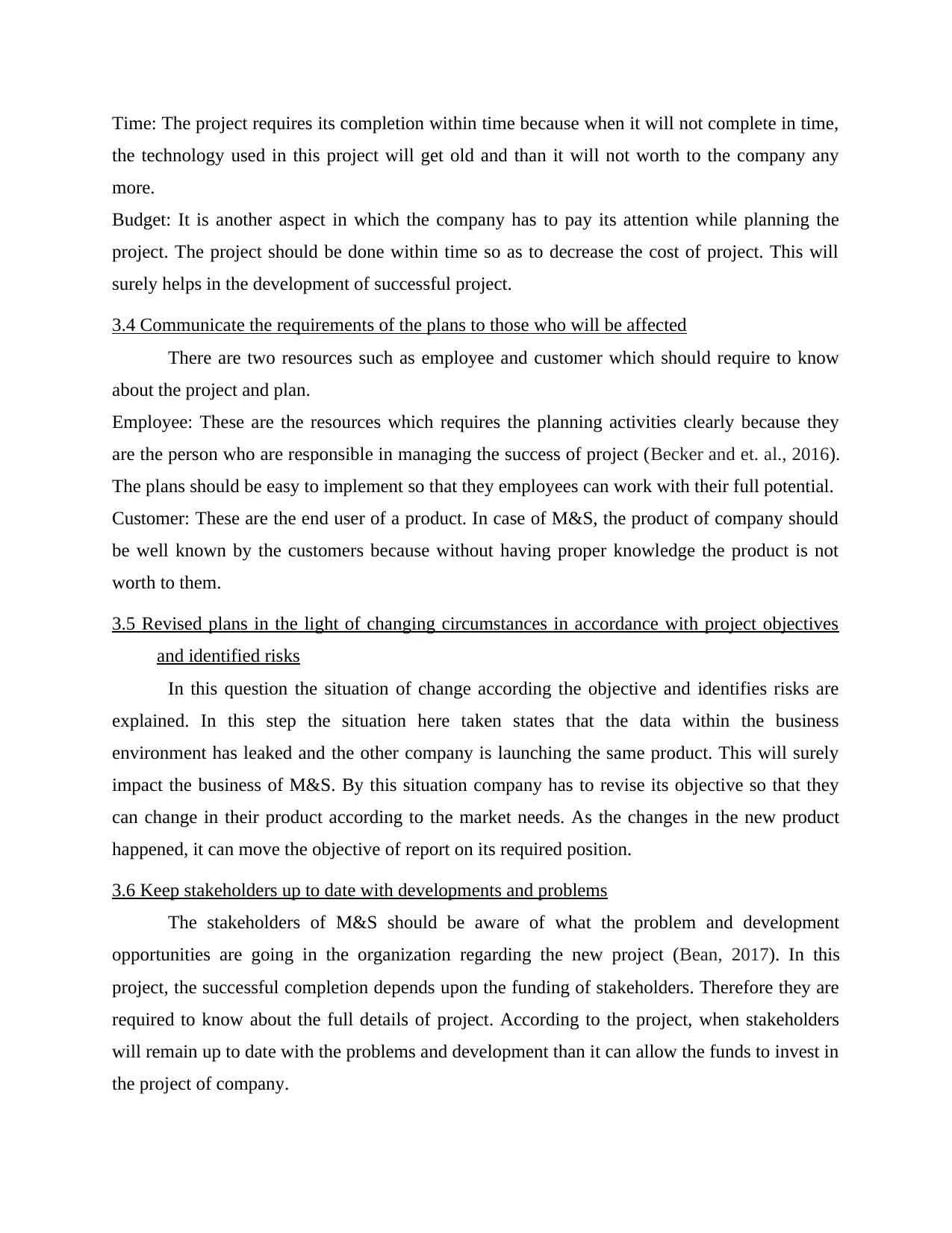
Time: The project requires its completion within time because when it will not complete in time,
the technology used in this project will get old and than it will not worth to the company any
more.
Budget: It is another aspect in which the company has to pay its attention while planning the
project. The project should be done within time so as to decrease the cost of project. This will
surely helps in the development of successful project.
3.4 Communicate the requirements of the plans to those who will be affected
There are two resources such as employee and customer which should require to know
about the project and plan.
Employee: These are the resources which requires the planning activities clearly because they
are the person who are responsible in managing the success of project (Becker and et. al., 2016).
The plans should be easy to implement so that they employees can work with their full potential.
Customer: These are the end user of a product. In case of M&S, the product of company should
be well known by the customers because without having proper knowledge the product is not
worth to them.
3.5 Revised plans in the light of changing circumstances in accordance with project objectives
and identified risks
In this question the situation of change according the objective and identifies risks are
explained. In this step the situation here taken states that the data within the business
environment has leaked and the other company is launching the same product. This will surely
impact the business of M&S. By this situation company has to revise its objective so that they
can change in their product according to the market needs. As the changes in the new product
happened, it can move the objective of report on its required position.
3.6 Keep stakeholders up to date with developments and problems
The stakeholders of M&S should be aware of what the problem and development
opportunities are going in the organization regarding the new project (Bean, 2017). In this
project, the successful completion depends upon the funding of stakeholders. Therefore they are
required to know about the full details of project. According to the project, when stakeholders
will remain up to date with the problems and development than it can allow the funds to invest in
the project of company.
the technology used in this project will get old and than it will not worth to the company any
more.
Budget: It is another aspect in which the company has to pay its attention while planning the
project. The project should be done within time so as to decrease the cost of project. This will
surely helps in the development of successful project.
3.4 Communicate the requirements of the plans to those who will be affected
There are two resources such as employee and customer which should require to know
about the project and plan.
Employee: These are the resources which requires the planning activities clearly because they
are the person who are responsible in managing the success of project (Becker and et. al., 2016).
The plans should be easy to implement so that they employees can work with their full potential.
Customer: These are the end user of a product. In case of M&S, the product of company should
be well known by the customers because without having proper knowledge the product is not
worth to them.
3.5 Revised plans in the light of changing circumstances in accordance with project objectives
and identified risks
In this question the situation of change according the objective and identifies risks are
explained. In this step the situation here taken states that the data within the business
environment has leaked and the other company is launching the same product. This will surely
impact the business of M&S. By this situation company has to revise its objective so that they
can change in their product according to the market needs. As the changes in the new product
happened, it can move the objective of report on its required position.
3.6 Keep stakeholders up to date with developments and problems
The stakeholders of M&S should be aware of what the problem and development
opportunities are going in the organization regarding the new project (Bean, 2017). In this
project, the successful completion depends upon the funding of stakeholders. Therefore they are
required to know about the full details of project. According to the project, when stakeholders
will remain up to date with the problems and development than it can allow the funds to invest in
the project of company.
⊘ This is a preview!⊘
Do you want full access?
Subscribe today to unlock all pages.

Trusted by 1+ million students worldwide
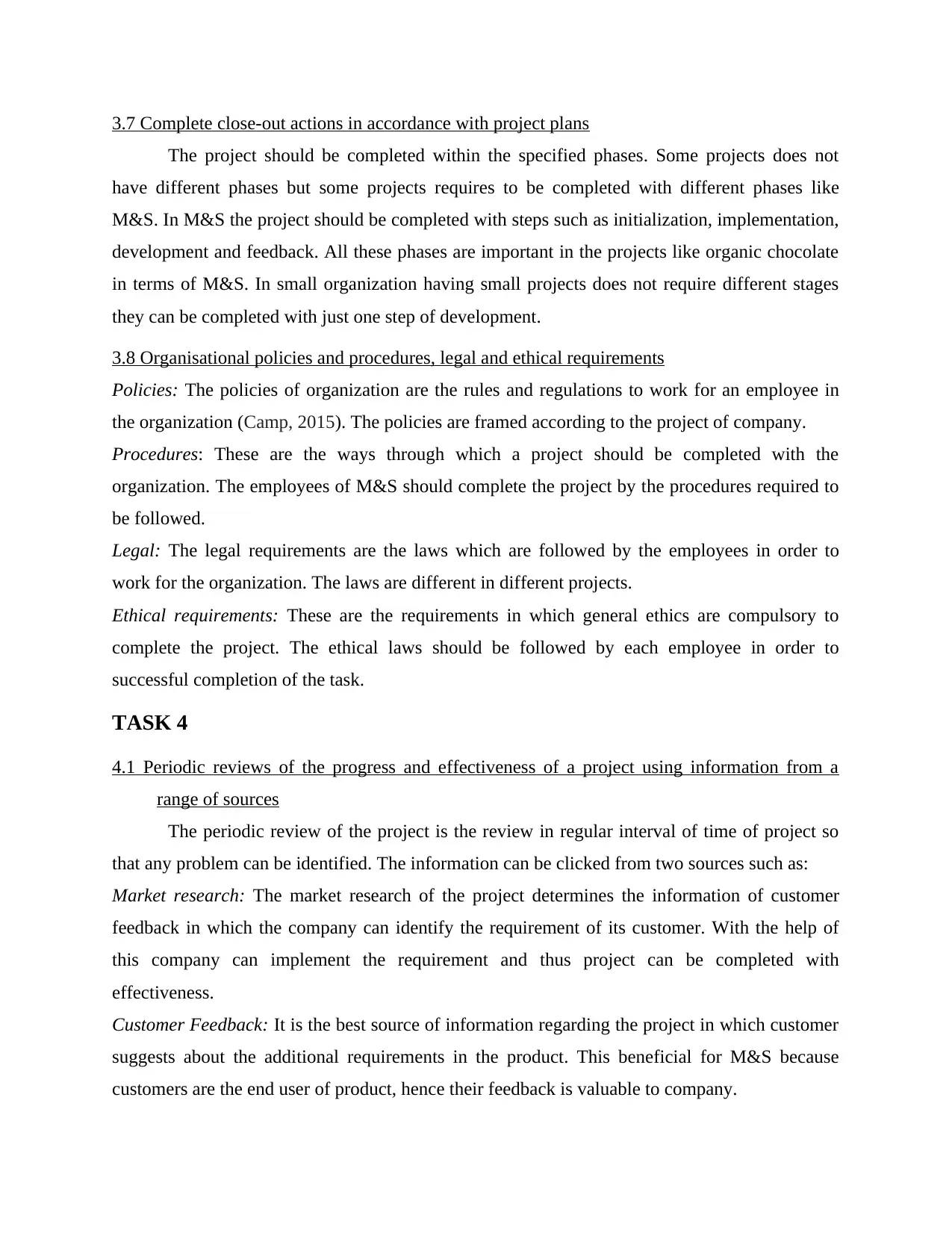
3.7 Complete close-out actions in accordance with project plans
The project should be completed within the specified phases. Some projects does not
have different phases but some projects requires to be completed with different phases like
M&S. In M&S the project should be completed with steps such as initialization, implementation,
development and feedback. All these phases are important in the projects like organic chocolate
in terms of M&S. In small organization having small projects does not require different stages
they can be completed with just one step of development.
3.8 Organisational policies and procedures, legal and ethical requirements
Policies: The policies of organization are the rules and regulations to work for an employee in
the organization (Camp, 2015). The policies are framed according to the project of company.
Procedures: These are the ways through which a project should be completed with the
organization. The employees of M&S should complete the project by the procedures required to
be followed.
Legal: The legal requirements are the laws which are followed by the employees in order to
work for the organization. The laws are different in different projects.
Ethical requirements: These are the requirements in which general ethics are compulsory to
complete the project. The ethical laws should be followed by each employee in order to
successful completion of the task.
TASK 4
4.1 Periodic reviews of the progress and effectiveness of a project using information from a
range of sources
The periodic review of the project is the review in regular interval of time of project so
that any problem can be identified. The information can be clicked from two sources such as:
Market research: The market research of the project determines the information of customer
feedback in which the company can identify the requirement of its customer. With the help of
this company can implement the requirement and thus project can be completed with
effectiveness.
Customer Feedback: It is the best source of information regarding the project in which customer
suggests about the additional requirements in the product. This beneficial for M&S because
customers are the end user of product, hence their feedback is valuable to company.
The project should be completed within the specified phases. Some projects does not
have different phases but some projects requires to be completed with different phases like
M&S. In M&S the project should be completed with steps such as initialization, implementation,
development and feedback. All these phases are important in the projects like organic chocolate
in terms of M&S. In small organization having small projects does not require different stages
they can be completed with just one step of development.
3.8 Organisational policies and procedures, legal and ethical requirements
Policies: The policies of organization are the rules and regulations to work for an employee in
the organization (Camp, 2015). The policies are framed according to the project of company.
Procedures: These are the ways through which a project should be completed with the
organization. The employees of M&S should complete the project by the procedures required to
be followed.
Legal: The legal requirements are the laws which are followed by the employees in order to
work for the organization. The laws are different in different projects.
Ethical requirements: These are the requirements in which general ethics are compulsory to
complete the project. The ethical laws should be followed by each employee in order to
successful completion of the task.
TASK 4
4.1 Periodic reviews of the progress and effectiveness of a project using information from a
range of sources
The periodic review of the project is the review in regular interval of time of project so
that any problem can be identified. The information can be clicked from two sources such as:
Market research: The market research of the project determines the information of customer
feedback in which the company can identify the requirement of its customer. With the help of
this company can implement the requirement and thus project can be completed with
effectiveness.
Customer Feedback: It is the best source of information regarding the project in which customer
suggests about the additional requirements in the product. This beneficial for M&S because
customers are the end user of product, hence their feedback is valuable to company.
Paraphrase This Document
Need a fresh take? Get an instant paraphrase of this document with our AI Paraphraser
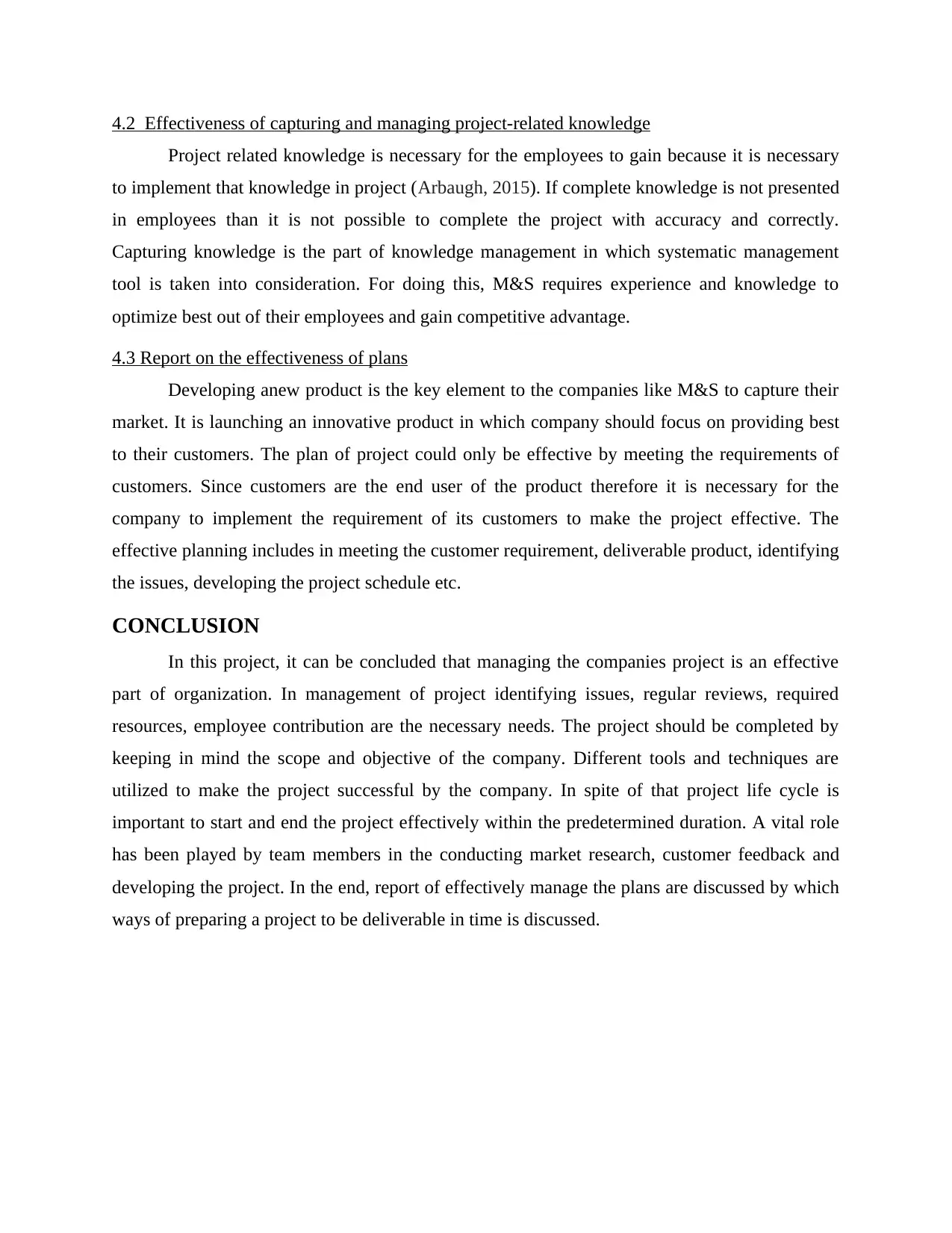
4.2 Effectiveness of capturing and managing project-related knowledge
Project related knowledge is necessary for the employees to gain because it is necessary
to implement that knowledge in project (Arbaugh, 2015). If complete knowledge is not presented
in employees than it is not possible to complete the project with accuracy and correctly.
Capturing knowledge is the part of knowledge management in which systematic management
tool is taken into consideration. For doing this, M&S requires experience and knowledge to
optimize best out of their employees and gain competitive advantage.
4.3 Report on the effectiveness of plans
Developing anew product is the key element to the companies like M&S to capture their
market. It is launching an innovative product in which company should focus on providing best
to their customers. The plan of project could only be effective by meeting the requirements of
customers. Since customers are the end user of the product therefore it is necessary for the
company to implement the requirement of its customers to make the project effective. The
effective planning includes in meeting the customer requirement, deliverable product, identifying
the issues, developing the project schedule etc.
CONCLUSION
In this project, it can be concluded that managing the companies project is an effective
part of organization. In management of project identifying issues, regular reviews, required
resources, employee contribution are the necessary needs. The project should be completed by
keeping in mind the scope and objective of the company. Different tools and techniques are
utilized to make the project successful by the company. In spite of that project life cycle is
important to start and end the project effectively within the predetermined duration. A vital role
has been played by team members in the conducting market research, customer feedback and
developing the project. In the end, report of effectively manage the plans are discussed by which
ways of preparing a project to be deliverable in time is discussed.
Project related knowledge is necessary for the employees to gain because it is necessary
to implement that knowledge in project (Arbaugh, 2015). If complete knowledge is not presented
in employees than it is not possible to complete the project with accuracy and correctly.
Capturing knowledge is the part of knowledge management in which systematic management
tool is taken into consideration. For doing this, M&S requires experience and knowledge to
optimize best out of their employees and gain competitive advantage.
4.3 Report on the effectiveness of plans
Developing anew product is the key element to the companies like M&S to capture their
market. It is launching an innovative product in which company should focus on providing best
to their customers. The plan of project could only be effective by meeting the requirements of
customers. Since customers are the end user of the product therefore it is necessary for the
company to implement the requirement of its customers to make the project effective. The
effective planning includes in meeting the customer requirement, deliverable product, identifying
the issues, developing the project schedule etc.
CONCLUSION
In this project, it can be concluded that managing the companies project is an effective
part of organization. In management of project identifying issues, regular reviews, required
resources, employee contribution are the necessary needs. The project should be completed by
keeping in mind the scope and objective of the company. Different tools and techniques are
utilized to make the project successful by the company. In spite of that project life cycle is
important to start and end the project effectively within the predetermined duration. A vital role
has been played by team members in the conducting market research, customer feedback and
developing the project. In the end, report of effectively manage the plans are discussed by which
ways of preparing a project to be deliverable in time is discussed.
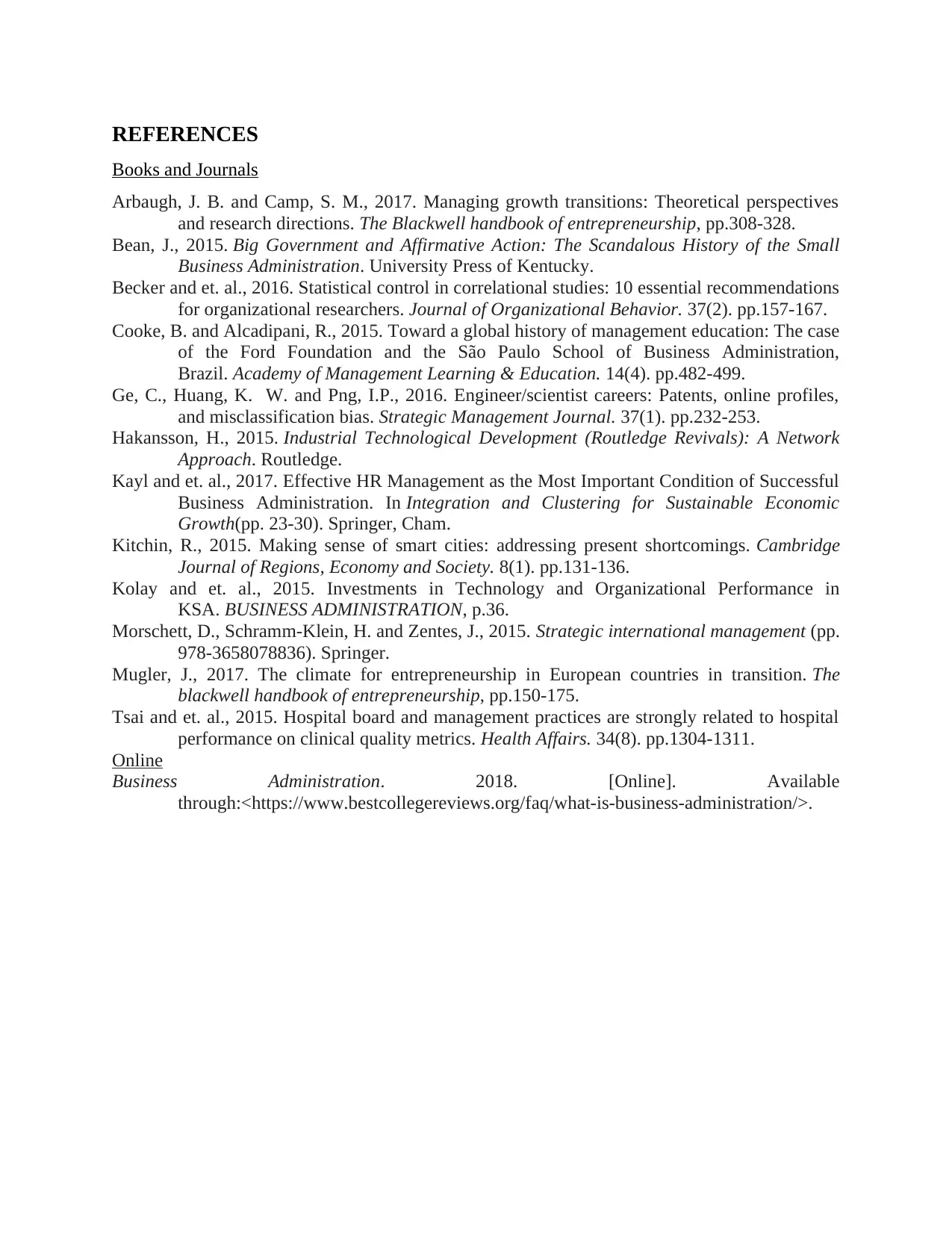
REFERENCES
Books and Journals
Arbaugh, J. B. and Camp, S. M., 2017. Managing growth transitions: Theoretical perspectives
and research directions. The Blackwell handbook of entrepreneurship, pp.308-328.
Bean, J., 2015. Big Government and Affirmative Action: The Scandalous History of the Small
Business Administration. University Press of Kentucky.
Becker and et. al., 2016. Statistical control in correlational studies: 10 essential recommendations
for organizational researchers. Journal of Organizational Behavior. 37(2). pp.157-167.
Cooke, B. and Alcadipani, R., 2015. Toward a global history of management education: The case
of the Ford Foundation and the São Paulo School of Business Administration,
Brazil. Academy of Management Learning & Education. 14(4). pp.482-499.
Ge, C., Huang, K. W. and Png, I.P., 2016. Engineer/scientist careers: Patents, online profiles,
and misclassification bias. Strategic Management Journal. 37(1). pp.232-253.
Hakansson, H., 2015. Industrial Technological Development (Routledge Revivals): A Network
Approach. Routledge.
Kayl and et. al., 2017. Effective HR Management as the Most Important Condition of Successful
Business Administration. In Integration and Clustering for Sustainable Economic
Growth(pp. 23-30). Springer, Cham.
Kitchin, R., 2015. Making sense of smart cities: addressing present shortcomings. Cambridge
Journal of Regions, Economy and Society. 8(1). pp.131-136.
Kolay and et. al., 2015. Investments in Technology and Organizational Performance in
KSA. BUSINESS ADMINISTRATION, p.36.
Morschett, D., Schramm-Klein, H. and Zentes, J., 2015. Strategic international management (pp.
978-3658078836). Springer.
Mugler, J., 2017. The climate for entrepreneurship in European countries in transition. The
blackwell handbook of entrepreneurship, pp.150-175.
Tsai and et. al., 2015. Hospital board and management practices are strongly related to hospital
performance on clinical quality metrics. Health Affairs. 34(8). pp.1304-1311.
Online
Business Administration. 2018. [Online]. Available
through:<https://www.bestcollegereviews.org/faq/what-is-business-administration/>.
Books and Journals
Arbaugh, J. B. and Camp, S. M., 2017. Managing growth transitions: Theoretical perspectives
and research directions. The Blackwell handbook of entrepreneurship, pp.308-328.
Bean, J., 2015. Big Government and Affirmative Action: The Scandalous History of the Small
Business Administration. University Press of Kentucky.
Becker and et. al., 2016. Statistical control in correlational studies: 10 essential recommendations
for organizational researchers. Journal of Organizational Behavior. 37(2). pp.157-167.
Cooke, B. and Alcadipani, R., 2015. Toward a global history of management education: The case
of the Ford Foundation and the São Paulo School of Business Administration,
Brazil. Academy of Management Learning & Education. 14(4). pp.482-499.
Ge, C., Huang, K. W. and Png, I.P., 2016. Engineer/scientist careers: Patents, online profiles,
and misclassification bias. Strategic Management Journal. 37(1). pp.232-253.
Hakansson, H., 2015. Industrial Technological Development (Routledge Revivals): A Network
Approach. Routledge.
Kayl and et. al., 2017. Effective HR Management as the Most Important Condition of Successful
Business Administration. In Integration and Clustering for Sustainable Economic
Growth(pp. 23-30). Springer, Cham.
Kitchin, R., 2015. Making sense of smart cities: addressing present shortcomings. Cambridge
Journal of Regions, Economy and Society. 8(1). pp.131-136.
Kolay and et. al., 2015. Investments in Technology and Organizational Performance in
KSA. BUSINESS ADMINISTRATION, p.36.
Morschett, D., Schramm-Klein, H. and Zentes, J., 2015. Strategic international management (pp.
978-3658078836). Springer.
Mugler, J., 2017. The climate for entrepreneurship in European countries in transition. The
blackwell handbook of entrepreneurship, pp.150-175.
Tsai and et. al., 2015. Hospital board and management practices are strongly related to hospital
performance on clinical quality metrics. Health Affairs. 34(8). pp.1304-1311.
Online
Business Administration. 2018. [Online]. Available
through:<https://www.bestcollegereviews.org/faq/what-is-business-administration/>.
⊘ This is a preview!⊘
Do you want full access?
Subscribe today to unlock all pages.

Trusted by 1+ million students worldwide
1 out of 12
Related Documents
Your All-in-One AI-Powered Toolkit for Academic Success.
+13062052269
info@desklib.com
Available 24*7 on WhatsApp / Email
![[object Object]](/_next/static/media/star-bottom.7253800d.svg)
Unlock your academic potential
Copyright © 2020–2025 A2Z Services. All Rights Reserved. Developed and managed by ZUCOL.





